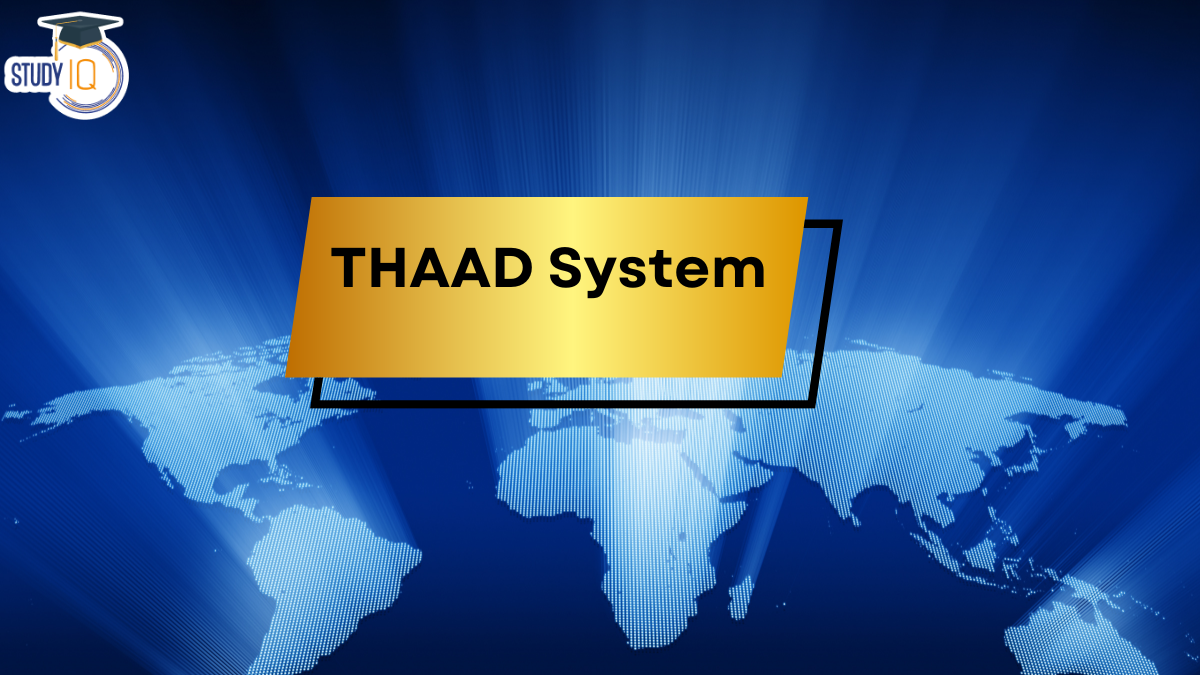Table of Contents
The Terminal High Altitude Area Defense (THAAD) system is a cutting-edge missile defense technology developed by Lockheed Martin, aimed at intercepting and neutralizing short, medium, and intermediate-range ballistic missiles. As the geopolitical landscape continues to evolve, particularly in regions like the Middle East and the Indo-Pacific, understanding the implications and functionalities of THAAD has become increasingly important for UPSC aspirants. This article delves into the THAAD system’s features, operational capabilities, significance in international relations, and its relevance in contemporary security discourse.
About Terminal High Altitude Area Defense (THAAD)
- Purpose: Designed to intercept and destroy short, medium and intermediate-range ballistic missiles during their terminal phase of flight.
- Components
- Interceptor Missiles: Single-stage, solid-fuel rocket motor with thrust vectoring.
- Radar System: Radar system that detects and tracks incoming missiles at ranges from 870 m to 3,000 km.
- Launcher Vehicle: Mobile platform based on a heavy expanded mobility tactical truck (HEMTT), capable of carrying up to eight interceptors.

- Operational Capabilities
- Intercepts missiles both inside (endoatmospheric) and outside (exoatmospheric) the atmosphere.
- High lethality with proven hit-to-kill capability, which means it destroys targets through kinetic energy rather than explosive warheads.
- Countries Using THAAD
- United States: Primary developer and operator.
- South Korea, United Arab Emirates, Israel, Saudi Arabia
THAAD Missile Defense System in Israel
The Terminal High Altitude Area Defense (THAAD) system is a sophisticated missile defense system developed by Lockheed Martin. It is designed to intercept and destroy short-, medium, and intermediate-range ballistic missiles during their terminal phase of flight, both inside and outside the Earth’s atmosphere.
Key Features
- Interception Capability: THAAD can intercept incoming missiles at altitudes ranging from 150 to 200 kilometers (93 to 124 miles).
- Kinetic Kill Mechanism: Unlike traditional interceptors that use explosive warheads, THAAD employs kinetic energy to destroy threats by colliding with them at high speeds.
- System Components:
- Launchers: Six truck-mounted launchers.
- Interceptors: Up to 48 interceptors, with each launcher capable of carrying eight.
- Radar: An advanced tracking radar that detects, tracks, and discriminates incoming threats.
- Command and Control: Integrated systems for effective operational coordination.
Recent Deployment in Israel
- Strategic Context: The U.S. is deploying THAAD to Israel in response to escalating tensions with Iran, especially following missile attacks attributed to Iranian forces.
- Testing New Threats: The deployment aims to assess THAAD’s effectiveness against Iranian hypersonic missiles, particularly the Fattah missile, which poses new challenges for missile defense systems.
- U.S. Troops Involvement: U.S. soldiers will accompany the system to operate it, as the complexity of the system requires trained personnel.
Integration with Israel’s Air Defense
- THAAD will complement Israel’s existing air defense systems:
- Iron Dome: Designed to intercept short-range threats (4 to 70 km).
- David’s Sling: Targets medium-range threats (40 to 300 km).
- Arrow System: Focused on long-range missile threats (up to 2,400 km).
- Together, these systems create a multi-layered defense network to protect against a range of aerial threats.
Strategic Importance
- The deployment of THAAD underscores the U.S. commitment to Israel’s security, particularly as regional threats evolve.
- It enhances Israel’s defense capabilities and deterrence posture against potential ballistic missile attacks from adversaries, particularly Iran.
Cost and Availability
- A single THAAD battery can cost between $1 billion and $1.8 billion.
- The U.S. has deployed a limited number of THAAD batteries globally, with operational and logistical considerations impacting availability for further deployments.
Difference between THAAD Missile system & S-400 Missile system
| Feature | THAAD | S-400 |
| Range | 150-200 Km | Up to 400 Km |
| Type of Threats Engaged | Short/medium-range ballistic missiles | Aircraft, cruise missiles, and ballistic missiles |
| Missile Types | Single-stage solid-fuel rocket | Multiple missile types (48N6, 40N6, etc.) |
| Simultaneous Engagements | Limited to several targets | Can engage up to 36 targets simultaneously |
| Countries Deployed In | US, South Korea, UAE, Israel, Saudi Arabia | Russia, India, Turkey, China, Belarus |


 List of Chief Ministers of Jammu and Kas...
List of Chief Ministers of Jammu and Kas...
 Cabinet Committee on Security Suspends I...
Cabinet Committee on Security Suspends I...
 Pahalgam Terror Attack: All Eyes on Paha...
Pahalgam Terror Attack: All Eyes on Paha...






















